Before getting into the data analysis itself, it’s worth having a look at the Segunda B division in Spain. It’s the third division, but it’s not officially professional – though almost all its teams are anyway. It’s formed by four groups of 20 teams each, divided in regions and with B teams allowed to participate and even get promoted to Segunda División.
The huge amount of teams and players make Segunda B a difficult competition to scout, so data analysis is a great tool to get an idea of who the best players are. In this series we will analyse the players of La Liga B sides who are currently playing in Segunda B. These teams are Alavés, Athletic Club, Atlético, Barcelona, Celta, Espanyol, Getafe, Granada, Levante, Osasuna, Real Betis, Real Madrid, Real Sociedad, Sevilla, Valencia, Valladolid, and Villareal. Only Eibar, Leganés, and Mallorca have their B sides playing below the third division, and there’s almost no data for those leagues. For this analysis, we are taking only U23 players who have played at least 800 minutes this season.
In our first data analysis we looked at centre-backs, and this time we will have a look at central midfielders. Central midfielders can have a very different impact on the game depending on the role they play in their teams’ tactics, so we are going to consider different types of players in our analysis. There are 39 central midfielders in Segunda B who play for a B side and have been on the pitch for more than 800 minutes, and we will try to highlight the best of them using statistics.
Successful offensive and defensive actions
In this first part of the analysis, we are going to use some general data to assess the playing style and level of involvement of all the players we are considering. To do so, we are going to compare their total successful defensive and offensive actions per 90.
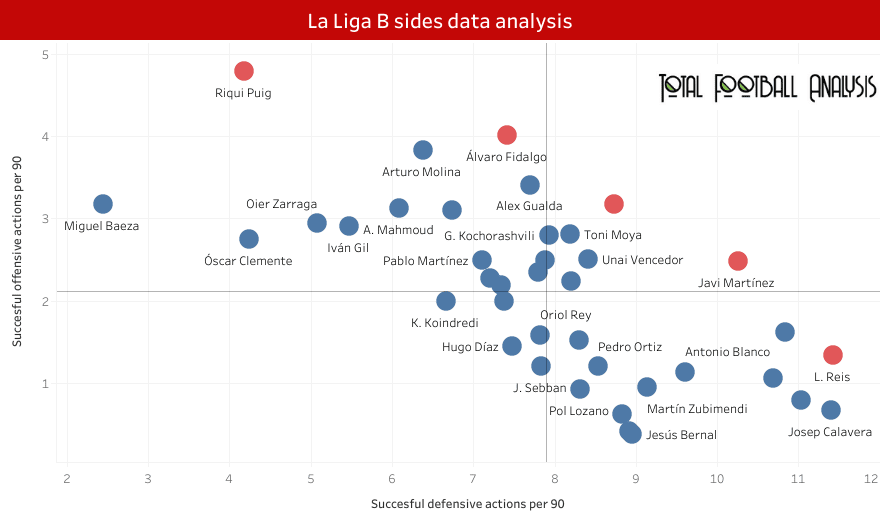
This first chart gives us an idea of which phase of the game each player affects more. The first player we need to highlight is Barcelona’s Riqui Puig. Puig is the player with the most successful offensive actions with 4.79 per 90 but the second-worst in successful defensive actions per 90 with just 4.18. The small playmaker is enjoying his breakthrough season at Barcelona B and he will appear later on in this data analysis.
Moving to the opposite side of the chart, we find another Barcelona B player, Ludovit Reis. The Dutch midfielder has impressed in his first season at Barcelona and is the player with the most successful defensive actions per 90 with 11.43. However, his low attacking outcome raises doubts about his suitability to Barcelona’s playing style as it’s proven by his only 1.34 successful offensive actions per 90.
Getting into a more intermediate style, we find Real Valladolid’s Kike Pérez and Osasuna’s Javi Martínez. Both of them rank above average in successful defensive and offensive actions per 90, contributing in both phases of the game. Pérez contributes more in the attacking phase than Martínez (3.17 vs 2.48 successful offensive actions per 90), but Martínez is more important in the defensive side (10.25 vs 8.73 successful defensive actions per 90).
Lastly, Real Madrid’s Álvaro Fidalgo also seems an interesting profile. He ranks just below average in successful defensive actions (7.42 per 90) but second in successful offensive actions (4.01 per 90), so he seems and attacking-minded all-around midfielder. Aged 23, it doesn’t seem likely that Fidalgo gets into the Real Madrid first squad, so several teams should be looking at his situation.
Winning duels
Similar to the previous part, this chart will show both successful defensive and offensive duels. With this, we aim to show how often players successfully engage in duels both on and off the ball, giving us an idea of how they behave in these individual battles.
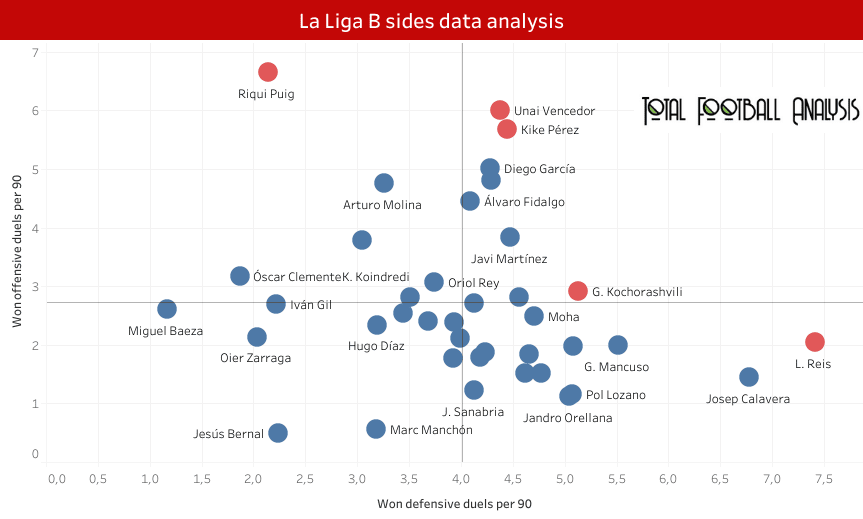
Again, Barcelona B has the best in successful offensive and defensive duels. Puig may not be the biggest or strongest, but his agility, intelligence, technique and pace allow him to win offensive duels and keep the ball in difficult situations, with 6.65 offensive duels won per 90. He’s far below average in the defensive duels part winning just 2.14 per 90.
Oppositely, Reis is the best at winning defensive duels. The Dutchman’s aggressiveness, strength and intensity make him win 7.41 defensive duels per 90. However, he’s not too bad going forward, using those same skills to win 2.04 offensive duels per 90, which is just below average.
Let’s take a look at three players who are above average in both metrics. First, Athletic Club’s Unai Vencedor, who is second-best in offensive duels won (6.01 per 90) but still manages to be above average in the defensive part (4.38 defensive duels won per 90). Aged just 19, Vencedor has already made his debut in the first team, and his ability to win duels fits very well in the Basques’ style.
Near Vencedor we see Valladolid’s Kike Pérez, who was already highlighted in the previous part of this analysis. The 23-years-old midfielder is above average in both metrics (4.45 defensive and 5.68 offensive duels won per 90) and has already made his first-team debut.
A more defensive profile but still above average in both metrics is Levante’s Giorgi Kochorashvili. The 20-year-old Georgian has impressed this season, averaging 5.13 successful defensive duels and 2.12 successful offensive duels per 90, and could be an interesting player to follow in the near future. He has been training with the first team after the coronavirus break.
It’s also worth pointing out how Álvaro Fidalgo and Javi Martínez, also mentioned before, are above average in winning offensive and defensive duels, proving again they are quite complete in the way they affect games.
Defending abilities
In this part we will start looking at how the players behave in specific parts of the game, starting with the defensive part. We have plotted our midfielders using total defensive duels per 90 (x-axis) and percentage of won defensive duels (y-axis). To this, we have added possession adjusted interceptions in the colour, with blue being below-average, red above-average and the intensity representing how close to the top/bottom they are.
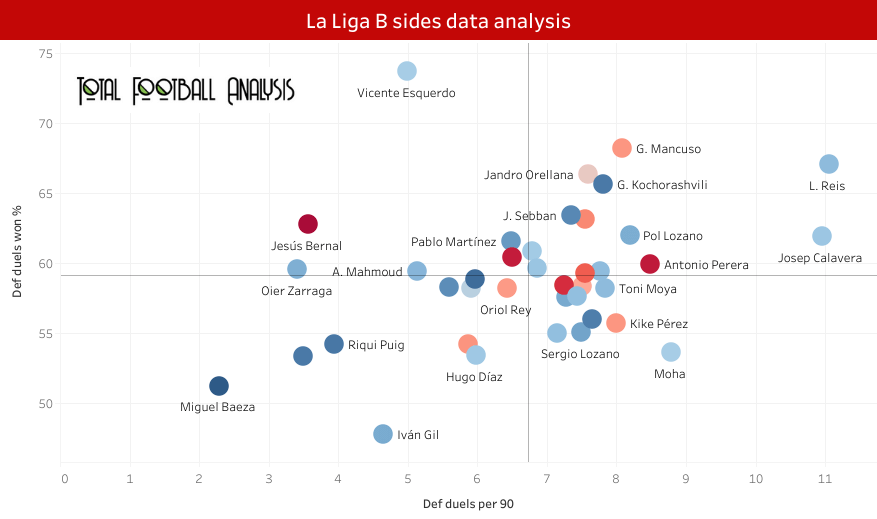
We already knew from our previous analysis that Reis would be well-ranked here. He gets involved in 11.05 defensive duels per 90 and wins 67.05% of them. However, his possession adjusted interceptions are below average (4.8 per 90), and his defensive style seems to be based more on intensity and contact than on positioning. This is another reason why he may not be the best fit for Barcelona. Kochorashvili and Fidalgo are also above-average in total defensive duels and winning percentage but below-average in possession adjusted interceptions.
One of the best defensive central midfielders according to the stats is Real Valladolid’s Gianluca Mancuso. The 22-year-old Argentinian on loan from Vélez has impressed this season, ranking second in percentage of defensive duels won (68.24%) and well-above-average in defensive duels (8.08 per 90) and possession adjusted interceptions (6.36). Only four players apart from Mancuso rank above-average in the three metrics: Antonio Perera, Jandro Orellana, Javi Martínez and Martín Zubimendi.
Let’s start with Antonio Perera. The 23-year-old Alavés B midfielder ranks fourth in total defensive duels (8.48 per 90) and above average in winning percentage (59.9%), but he stands out in possession-adjusted interceptions (8.68 per 90). With over 2,000 minutes on the pitch this season, he’s a very important part of Alavés B and seems very competent in defence.
Jandro Orellana (Barcelona B) is also a good shout when it comes to the best defensive midfielders in our analysis. The 19-year-old midfielder ranks just below Mancuso in the three metrics we are considering with 66.39% of defensive duels won, 7.59 defensive duels per 90 and 5.72 possession-adjusted interceptions per 90.
Ball progression
In this section, we will see how good our midfielders are at progressing the ball with passes and runs. A midfielder’s ability to progress the ball is a very important part for his team’s attacks, breaking pressure lines, finding teammates in better positions and contributing to advance the attacks. We have plotted progressive runs per 90 (y-axis) and progressive passes per 90 (x-axis)
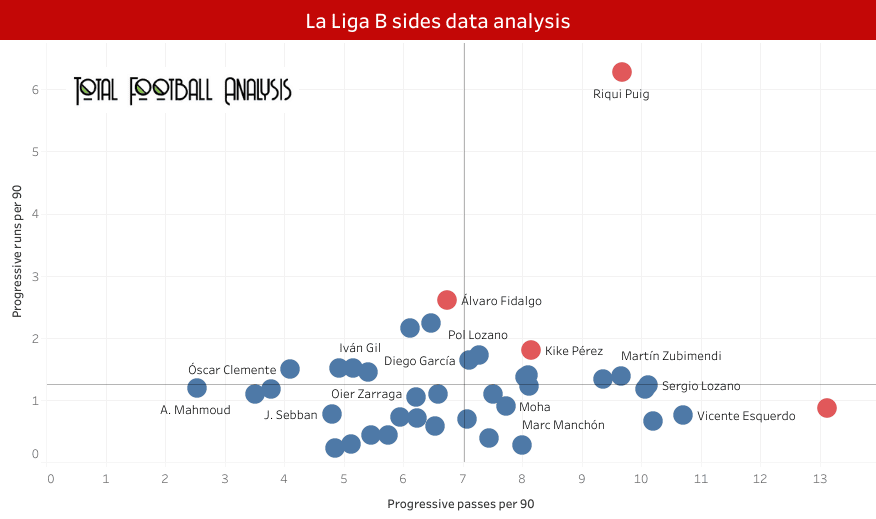
As in the previous attacking stats we looked at, Riqui Puig stands out in ball progression. He’s the best in progressive runs per 90 with 6.27, two times more than the second one. His pace and ability to turn under pressure and carry the ball forward are impressive, being a vital part of Barcelona B’s midfield. His progressive passes are also well-above average with 9.68 per 90. This is the part of the game where Puig shows all his talent and the reason why Barcelona still have a lot of faith in the 20-year-old playmaker.
On the progressive-passes side, Levante B’s Jesús Bernal is the clear winner with 13.12 progressive passes per 90. However, he’s below average in progressive runs, and from what we could see in the defensive duels stats, he seems a positional defensive midfielder who rarely gets engaged in duels but with a high IQ to intercept balls (he’s first in possession-adjusted interceptions with 9.09 per 90) and progress the ball with passes. He’s worth having a look on video as he excels in some parts of the game but ranks very low in others.
As a more well-rounded ball-progressor, we have Kike Pérez again. We have already seen how Pérez ranks above-average in defensive and offensive actions and duels, and he does again in progressive runs and passes. With 8.15 progressive passes and 1.81 progressive runs per 90, he’s not amazingly above average but shows how useful he is in this part of the game. He’s already training with the first team and could be given an opportunity in La Liga soon.
From the rest of the players we have mentioned in other parts of the analysis, Álvaro Fidalgo is one of the most impressive. While he’s a little bit below-average in progressive passes per 90 (6.74), he’s second in progressive runs (2.61 per 90), adding this to his already mentioned ability to contribute with his duel-winning ability and his contribution in attack and defence.
Other players we have mentioned before and are above-average in progressive runs and passes are Unai Vencedor and Javi Martínez, who are capable of affecting the game in several ways and are trustworthy options for their teams’ midfield.
Final third contribution and end-product
In this last part of our data analysis, we will focus on how dangerous the central midfielders are near and inside the box. To do this, we made the following chart with touches in the box per 90 on the y-axis and deep completions per 90 (passes aimed at the zone within 20 meters of the goal) on the x-axis. Also, the colour of the dot represents the sum of expected goals and expected assists, with red being high and blue, low.
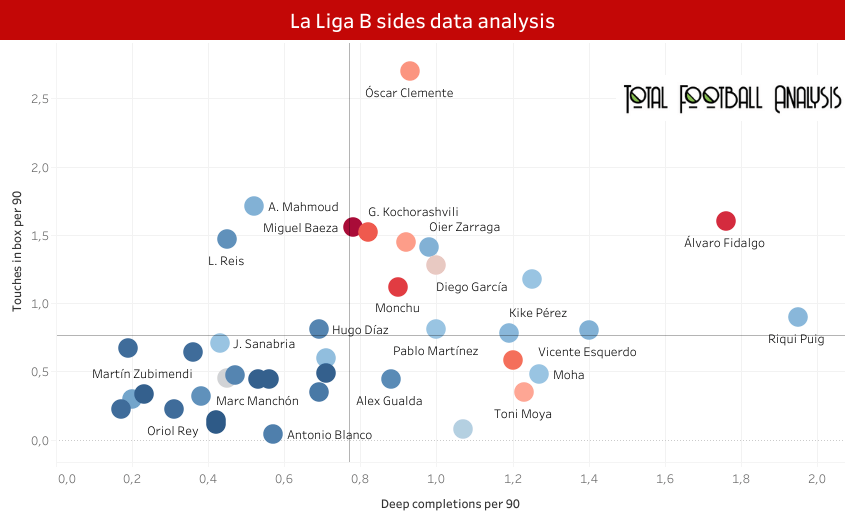
Again, two of our usual suspects appear very good in this comparison. Fidalgo is well above average in both metrics, being second in deep completions per 90 (1.76) and well above average in touches in the box per 90 (1.6). But apart from getting inside the box, his end product is usually good too, and he’s second in xG+xA per 90 with 0.39. Apart from being a good two-way player, Fidalgo can impact games in the final third and create goals for Real Madrid Castilla as well.
Riqui Puig is also interesting here. The Barcelona playmaker is the best in deep completions (1.95 per 90) and above average in touches in the box (0.9 per 90). However, even if he gets the ball to and inside the box, he doesn’t create a lot of scoring opportunities and averages a below-average 0.18 xG+xA per 90. So while Puig is a master at progressing the ball and getting it into and around the box, his passes and shots are not too dangerous.
The other player who stands out is Atlético de Madrid’s 21-year-old Óscar Clemente. He’s by far the best in touches in the box (2.7 per 90) and above-average in deep completions (0.93 per 90). He’s also a threat to the opposition with 0.38 xG+xA per 90. However, it’s normal he ranks that high as he’s used in more advanced positions in a lot of matches, but anyway, his stats are very impressive.
To evaluate the rest of the players and their goal contribution, we used the next graph. On the y-axis, we have expected goals per 90, and on the x-axis, we have expected assists per 90. We used the expected value instead of the actual goals and assist because it’s better to understand how consistently the players get into good shooting positions or make good passes regardless of the result, which may vary depending on luck.
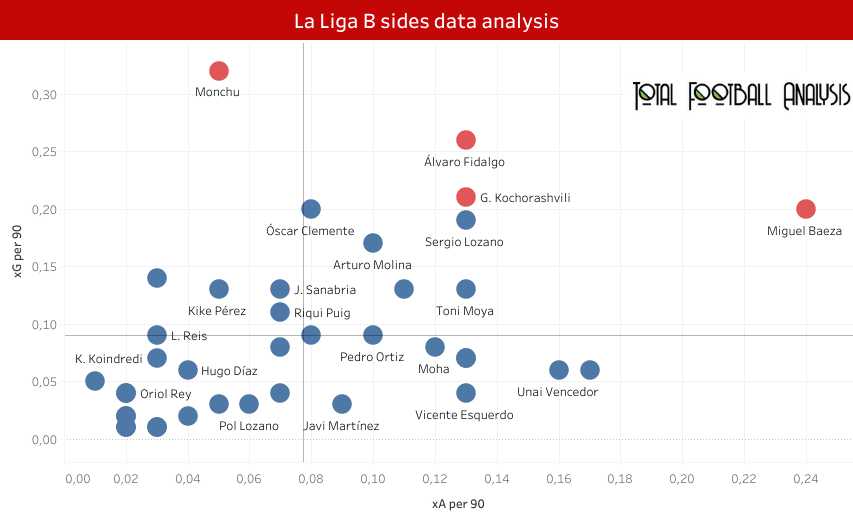
We have already spoken about Fidalgo, so we will focus on Barcelona B’s Monchu now. With 0.32 xG per 90, Monchu is the central midfielder with the highest contribution in front of the goal. He has scored eight goals this season and is Barcelona B’s top scorer. He’s a very good set-pieces taker, scoring most of his goals from dead-ball situations.
On the other side, Miguel Baeza is by far the best when it comes to assisting his teammates. With 0.24 expected assists per 90, Real Madrid Castilla have a goal factory in this 20-year-old midfielder. He has also scored nine this season and his 0.2 xG per 90 is above average too.
Finally, Kochorashvili is an interesting one. We have already seen his stats suggest he’s a box-to-box midfielder, getting involved in lots of duels and a lot of defensive and offensive actions. But he also records good numbers in terms of his end product, with 0.34 xG+xA per 90. He seems to be a very complete midfielder and Levante may have found a hidden gem in him.
Shortlist
Seeing the players we have highlighted throughout this analysis, it’s time to make a final shortlist of the best central and defensive midfielders in La Liga B sides. We have taken different profiles as the roles a central midfielder can take are very varied.
Riqui Puig
The small Barcelona B playmaker is a master on the ball. His ball progression abilities are well above anyone else in the league, and he can take the ball forward either passing or dribbling and do it from deep or more advanced positions, as his touches in the box and deep completions prove. However, he still needs a lot of defensive development and has to affect the score much more often to become a regular Barcelona starter.
Álvaro Fidalgo
Real Madrid Castilla’s Fidalgo is a more complete option in the playmaker role. While he may not have Puig’s ability to beat pressure and progress the ball, Fidalgo still manages to be a good runner on the ball and his end product is much better, being one of the best players in terms of expected goals and assists. But he’s also very involved in defensive duties, ranking above average when we measure the ability to win duels and recover the ball. This complete playmaker will be one to watch when he leaves Real Madrid.
Ludovit Reis
When it comes to defensive midfielders, Barcelona B’s Ludovit Reis is one of the very best. The Dutchman ranks first in successful defensive actions and won defensive duels. His intensity is noted when we see he’s also the player who gets involved in the most defensive duels per 90, and he still has the energy to tally 1.47 touches in the box per 90, which is well above average. So he’s a defensive but not positional midfielder, pressing all around the pitch and working hard in defence and attack.
Gianluca Mancuso
But when it comes to defending deep and recovering balls, Mancuso is the real winner. The Valladolid B Argentinian midfielder ranks very highly in defensive duels per 90, defensive duels won and interceptions, proving he’s very complete when it comes to defending. His ability
on the ball is not very good, and he seems a purely defensive midfielder. Aged only 22, Mancuso could be a nice surprise if he stays at Valladolid, as he’s currently on loan from Vélez Sarsfield.Giorgi Kochorashvili
The last role we are analysing is the box-to-box midfielder. The best fit here is Levante’s Kochorashvili. The Georgian ranks above average in successful defensive and offensive actions and defensive and offensive duels won, proving he’s a two-way player. But the most impressive thing about him is his ability to create in the final third. He ranks very well in touches in the box and deep completions, and with 0.34 xG+xA per 90, he’s among the most dangerous midfielders in the Segunda B. He’s not the best at progressing the ball, but he knows how to get forward and could be a great pairing for a deep playmaker. He’s only 20, so Levante may have found a bargain given they only paid €250,000 for him last summer.
Conclusion
Choosing between the best talent in La Liga B sides is not easy. Many players could have been included in our final shortlist, and some of the most interesting ones that were left out are Monchu (Barcelona), Jandro Orellana (Barcelona), Kike Pérez (Real Valladolid), Unai Vencedor (Athletic Bilbao) or Javi Martínez (Osasuna). These would also deserve proper scouting because they stand out in several metrics.
La Liga B sides are full of good players in midfield. We will surely see some of these players become first-team regulars sooner than later, and it will be very interesting to see how they translate their good performances in the third division to the much more demanding first division.





Comments